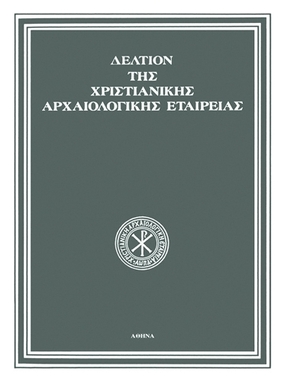Εικόνα του Βυζαντινού Μουσείου με σκηνές από το βίο της Αγίας Αικατερίνας : Ένα έργο της πρώιμης κρητικής ζωγραφικής
Part of : Δελτίον της Χριστιανικής Αρχαιολογικής Εταιρείας ; Vol.29, 1983, pages 77-98
Issue:
Pages:
77-98
Parallel Title:
An Early Cretan Icon with Two Scenes from the Life of Saint Catherine in Byzantine Museum
Section Title:
Articles
Abstract:
It is a small panel, measuring 0,44x0,25 m., which was among the numerous icons in the storehouse of the Museum. It is delicately painted, with two scenes from a saint's life, which, as we believe, is that of St. Catherine. The first scene depicts the event in St. Catherine's legend concerning her visit to the hermit and her mystic marriage with Christ. The marriage was not a part of the byzantine "martyrdom" of St. Catherine and does not occur in the Greek texts till the 17th century. But it was known in the Byzantine tradition as a mention of this in the Byzantine manuscripts reveals. More complete knowledge of this event derives from the late Latin texts, which preserve the whole story. The representation of St. Catherine's visit to the hermit, as it appears here, is an extremely rare example. If one searches for a compositional model, one might think of the similar scenes in the painting of the West, where the pictorial formula of the scene was created early in the 14th century. The most characteristic example is that of Andrea da Bologna in his wall painting of Santa Maria della Rocca at Offida. As the artist of our icon lacked complete Greek pictorial model, the illustration of this episode may result from a Greek treatment of a Latin and non-Byzantine subject. For that he used heterogeneous elements from other iconographical standard motifs already existing in early Cretan painting which would have been adapted particularly to the individual images of the scene. The image of St. Catherine's mother, for instance, may come from artist's different treatment of prophetess Anne in the scene of Presentation to the Temple, as it occurs in 15th century Cretan icons. In the case of the young friend of St. Catherine, what immediately comes to mind is one of the girls who followed Virgin in the scene of Presentation of the Virgin to the Temple, as it is depicted in some early Cretan icons too. Finally, the iconographical scheme of the hermit is easily explained if one assumes that in this case also the artist made use of similar motifs from the Latin manuscripts. Particularly, there are such images in the Latin manuscripts of Palermo Vat. lat. 375, fol. 9, which is surely adapted from earlier Byzantine manuscripts, with scenes from monastic life, as it is the Garett no 16 of Princeton and the Sin. codex 418 of John Climacus. The second scene entitled: ΟΙ ΡΗΤΟΡΕΣ ΕΜΒΑΛΑΩΝΤΑΙ ΕΙΣ ΤΗΝ ΚΑΜΙΝΟΝ (The rhetoricians are thrown in the furnace), illustrates one of the most familiar events in St. Catherine's cycle. The individual motifs encountered here were not new for the early Cretan and the Italian painting. First of all the soldiers in such helmets are found in the icons of 15th century in Crete, as the icon with the signature of Zafouris, in the Metropolitan Museum of N. York, and the icons with the martyrdom of St. Demetrius, in Benaki Museum and in Venice. But the same helmets in Giotto, Duccio and Simone Martini too. Secondly, the young figure in contraposto with his hands stretched across his body to the right and the face reversing to the left and the rhetor who bends to enter the arched opening of the furnace, were borrowed from the scene of the martyrdom of the Fourteen Martyrs (ms. gr. 183, Moscow). The same motif, with the figure entering a gate, is common in the Latin manuscript of 14th century (Escoriai no 19 and Turin ms. I.II 17, fol. 10) adapted from early Byzantine manuscripts. In the light of these observations we would assume that our artist remained attached to the stylistic conception, which characterises the Greek painting. However, he also aquired the ability of using Italian compositional schemes and motifs by assimilating them and introducing them subtly in his own composition. The same tendencies we find in the stylistic trends of the icon. But this eclectic multiformity characterises the Cretan painting of 15th century, the period when the Cretan school began to take shape. Thus, we believe that the icon is dated in the 15th century and localized in Crete. I iom that point of view our icon, which is related to that style and period, is extremely important.
Subject:
Subject (LC):




